
THIS SITE USES GOOGLE ANALYTICS TO ANALYSE TRAFFIC. CONTINUING TO USE THIS SITE MEANS YOU ACCEPT THE USE OF COOKIES.WE DO NOT COLLECT PERSONAL DATA LEARN MORE OR SEE OUR PRIVACY POLICY
SEVEN DAY CYCLIST
CYCLING, BUT NOT USUALLY RACING
LATEST UPDATE DECEMBER 30th 2025
HOW DO WE REACH THE OVERALL RATINGS FOR PRODUCTS WE REVIEW?
Uncle Pete’s Handmade Cycling Caps
45g 61cm (as tested) £30
Uncle Pete’s Handmade Cycling Caps are traditional peaked cycling caps made by hand by Pete van der Woude. They are handmade by hand and offer something a bit different to mass produced caps – and not just design. I really like them, and not just because of the designs.
Pros: designs, neatly stitched, robust materials, no elastic, soft or hard peaks, personal contact with the maker, absorbs moisture well.
Cons: not so much a con, but do get that measurement right, best in warmer weather.
Specification
If you picture Uncle Pete van der Woude returning from a long day cycling to sit and labour by candlelight, as night falls, in his workshop at the back of some Flemish gabled cottage in the back streets of Ghent, you would not be alone. I did, until a closer look at his Etsy store revealed he is based in Bromley, Kent, England. No problem there. Bromley may not be on the Tour of Flanders, but Uncle Pete clearly has a sense of tradition and creativity that combine to bring something new to that time-honoured cycling staple, the cap with that narrow peak.
Pete tells us that he had a Dutch Grandfather. However, his inspiration came from experience. “I started making my own cycling caps years ago because nothing off the peg fitted properly. I used to cut the elastic the moment I got a cap home, hoping like hell that it wouldn't try and push my brains out of my eyeballs. I was seldom lucky. So, I found a traditional four-piece pattern
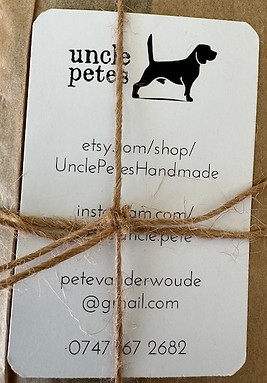
online, whipped out my sewing machine and had a go at making my own. It took a while to get the sizing right, but once I had a pattern that fit my oversize head, the experience of wearing a casquette was chalk and cheese.”
However, Pete has continued to innovate. Traditional caps are a four panel design, but Pete uses three panels. Why? “Four-piece caps are part of cycling heritage, but they're a pain to sew because eight pieces of fabric meet at the top of the crown, which either leaves you with untidy seams or a bit of a bobble. I started working on a three-piece design, which made construction easier and neater, and they fitted better too.”
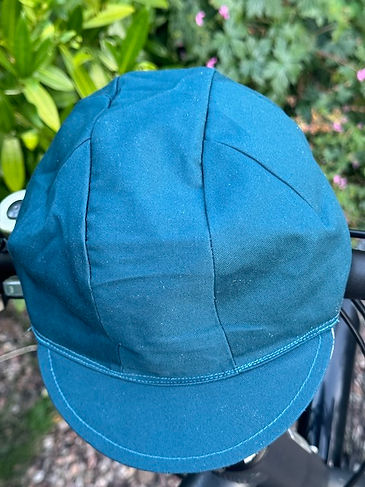
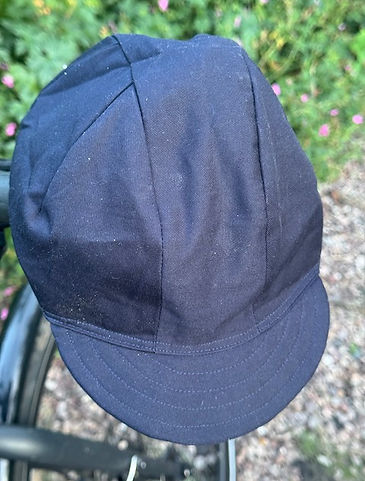
His casquettes are made from a variety of cottons; pure cotton, twill, and poplin. Polypropylene, add the finishing touch. These are cut and stitched by hand, and very neatly put together they are. There is something about the handmade; a personal connection between you and the maker. For some people, that will be a big factor in the spec.
The caps are lined, with a contrasting or complimentary fabric. This, as Pete points out, is different to the trad cap and makes them thicker than those I have come across in the mass-produced market. Lining and outer are stitched together at the edge, so there’s the only internal stitching smoothly joins the panels of the lining. This prevents discomfort that might arise from less refined stitching, aids absorption, and helps make each cap a little more different for each rider. Pete likes the idea that there’s something about your cap that other cyclists can’t see.
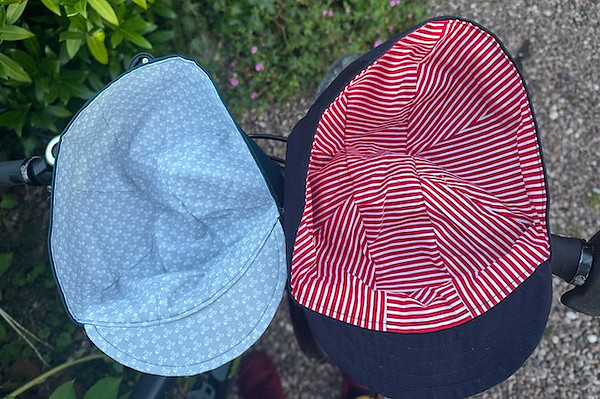
As Pete explained, the caps are not elasticated: another break from tradition. Of course, this makes a good fit really important to keep it in place when freewheeling down those hills.
Uncle Pete’s caps can have hard or soft peaks, however, he uses polypropylene. Pete feels that this is more durable than materials used in off-the-peg caps.
Size and Fit 4.75/5
Well, measure around your head at the point where you cap will sit comfortably. Size matters; I did it roughly half way between visits to the barber. My hair tends to grow in thickness as much as length, so this made sense to me. I’m not saying that you should do the same, just that it may be a consideration.
The caps Pete sent fitted like a glove. A rotten cliché for any writer, but, if the cap fits wear it. Even when my hair thickened up, it had enough stretch to deal with it and still feel comfortably snug. Post shearing, it remained a really neat fit, holding on at 35mph on the descent form Harmer Hill to Wem (Shropshire, England).
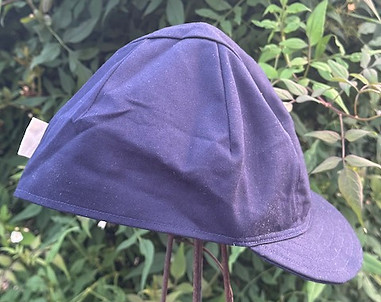
Pete describes his head as “over-sized”: mine is officially big, having been found to be the largest during an informal survey of Nottinghamshire school teachers in the 1980s. However, Pete deals with any size of cranium, although it may be that those with bigger bonces may notice the most difference.
Under the helmet? Well, probably best to adjust the cradle. If you are on the cusp between large and small helmet sizes, you may find it necessary to have a haircut if using Pete’s cap. OK, that is a trifle facetious, but may be a consideration when buying your next helmet, if you become a devotee of Uncle Pete.
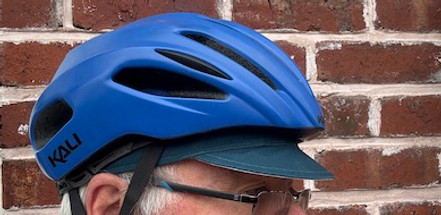
Care and durability 4/5
On his Etsy store, Pete recommends a hand wash or gentle machine programme. I’ve found both methods effective, but found no damage form a standard 30C machine wash. Very convenient as that temperature suits a good deal of other cycling gear, too. Repeated washing over a warm July and early August (plus a few hefty downpours and extended periods of rain) have not managed to loosen stitching are fade the colours, although I’d guess the latter will happen over time as that is what cotton fabrics tend to do.
Drying times have been very impressive. A sweat soaked cap after a bustling hour or two has been dry within an hour or so. After a machine wash a mere thirty minutes in the sunshine had the whole thing nice and dry – expect a bit longer in less favourable conditions. However, it will dry overnight without any assistance – good old cotton.
Performance 4/5
Sweat and rain absorption are really very good, with drying times to match. At the end of an hour-long commute in steady drizzle, the inner layer was only a little damp, and this had dried easily before home time. Sweat, like rain, is absorbed more effectively by the double layer and one barely notices. Cotton is very absorbent, so I haven’t been surprised that on day rides – helmetless (naughty me) there has been no sweat running down through my eye-brows! Now, please don’t think I am claiming cotton is waterproof; a hefty downpour or prolonged steady rain will get through. It is just that I have been impressed by how well the double layer of cotton works with moisture.
Under the helmet, things get sweatier more quickly, as you’d expect, but absorbency is still impressive, in my opinion – after all most road helmets are pretty well vented these days.
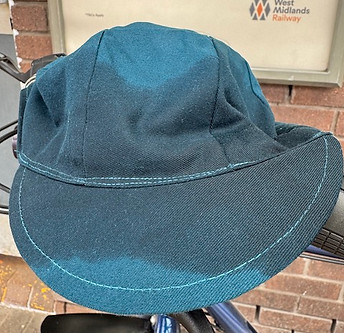
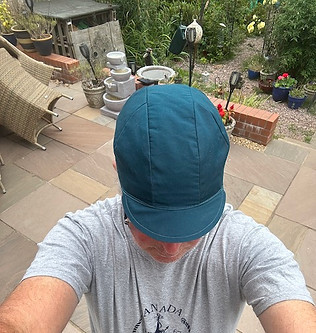
The peak holds up well – offering more extensive protection form rain and sun than most other caps I have worn. It is both broader and deeper than some favourite retro models.
The neat needle-work means that there are no annoying creases to pressurise between head and helmet. Without helmet – yes, I know we should all wear helmets all the time – the cap is supremely comfortable. I am with Pete, getting rid of that elastic works. Even better, the cloth is beautifully soft around the temples.
Finally, off the bike, it does not look totally silly, although it would not be my first choice of head-wear for a night on the town. One might wear it with an old striped rowing or cricket blazer, for example, if one desires a retro apparance.
Value 3.75/5
Thirty pounds? You’ll find cheaper, but will you find the same quality? Many roadies I know are keen on caps that align them with teams or events. For example, the Buff Pack Bike Cap, come sin around the same price and has some advantages in inclement weather as well as a nice broad peak. However, polyester is, in my experience less tactile than cotton.
I like the Showers Pass Elite Cycling Cap. This is now £35, but is waterproof and great for winter use under a helmet; however, it comes in one size and the peak is not to everyone’s taste. Even so, a good bet for hell and high water riders.
Prendas Ciclismo offer a wide range of team and event caps, and these have served very well. Their Lisboa Cap features a DWR coating and coms in around £20. However, it requires a gentle hand-wash.
With no waterproofing, but a decent sized peak and some idiosyncratic designs are models form Cyclogy, including their Baja Cap.
In the long run, their ios something for most tastes and requirements What price your own custom styled cap? Even, then Uncle Pete’s Handmade Caps score competitively on performance, particularly for riding in warmer weather.
Summary
A cap should have a place in every keen cyclist’s wardrobe or, even better, on their head, so whether for shading form the sun or keeping out the draft under your helmet, it is a very handy investment. Is a handmade, customized cap for you? Well, there are some who relish the sentiment of a connection with the maker. Additional thickness also adds seasonal advantages to Uncle Pete’s version, whilst there are other practical advantages, too. A cap for all seasons? Maybe not – I ‘ll still have the waterproof one to hand in winter – but certainly one that has distinct advantages as well as some additional street cred.
Verdict: 4/5 Love it, but I’m a sucker for tradition.
Steve Dyster
https://www.etsy.com/shop/UnclePetesHandmade?dd_referrer=https%3A%2F%2Fwww.google.com%2F
PUBLISHED AUGUST 2025





